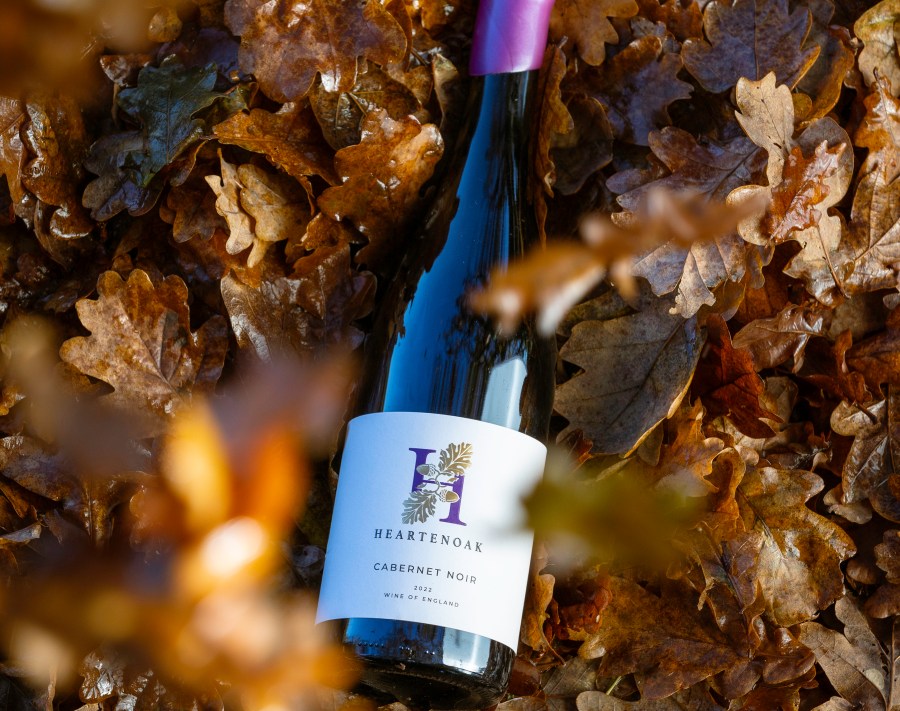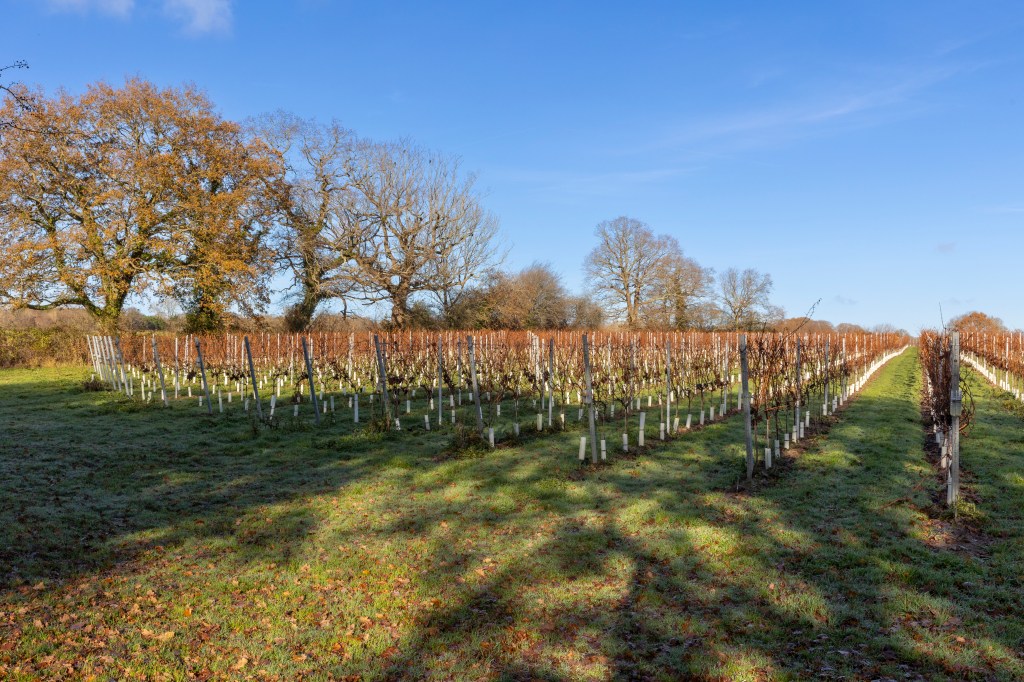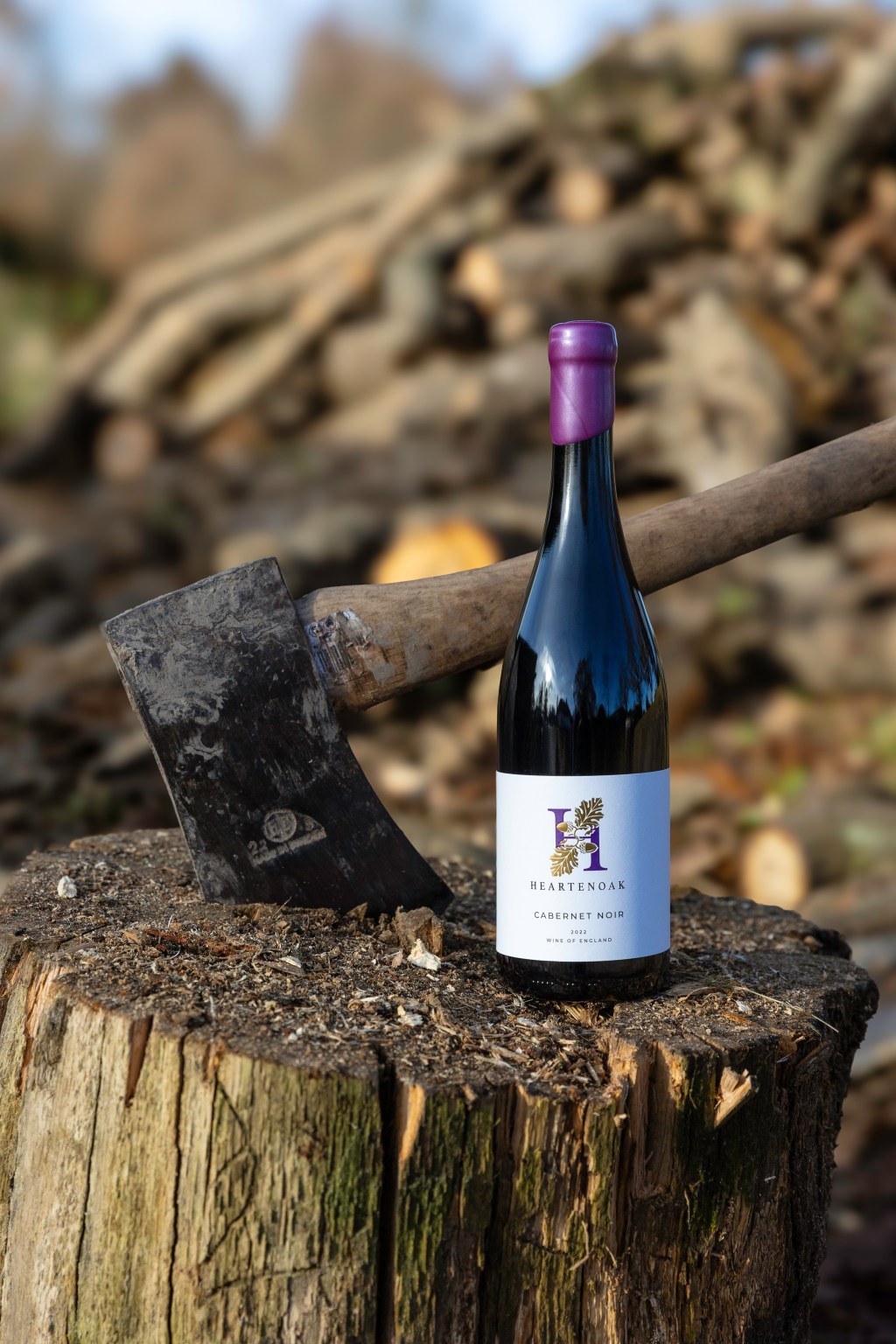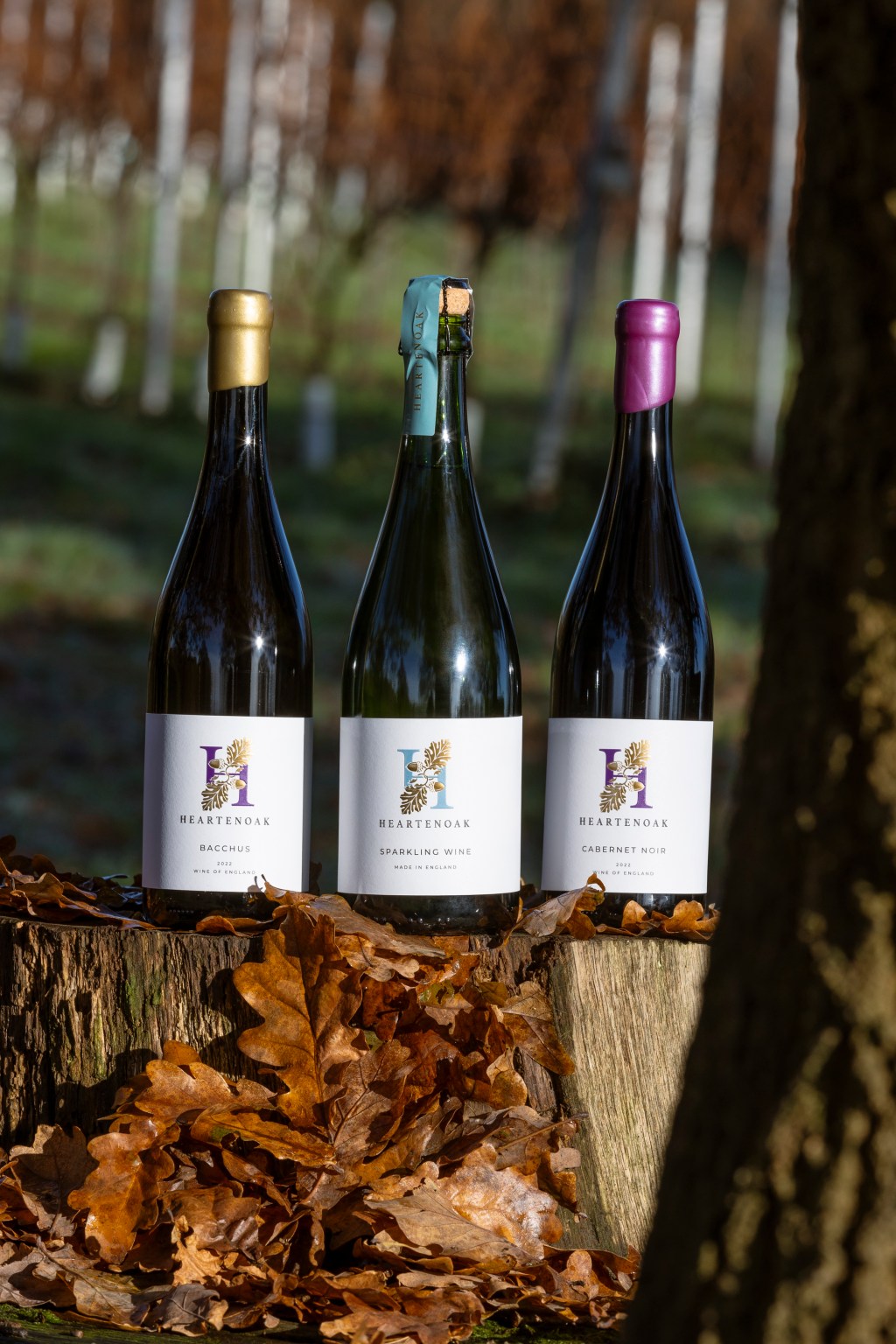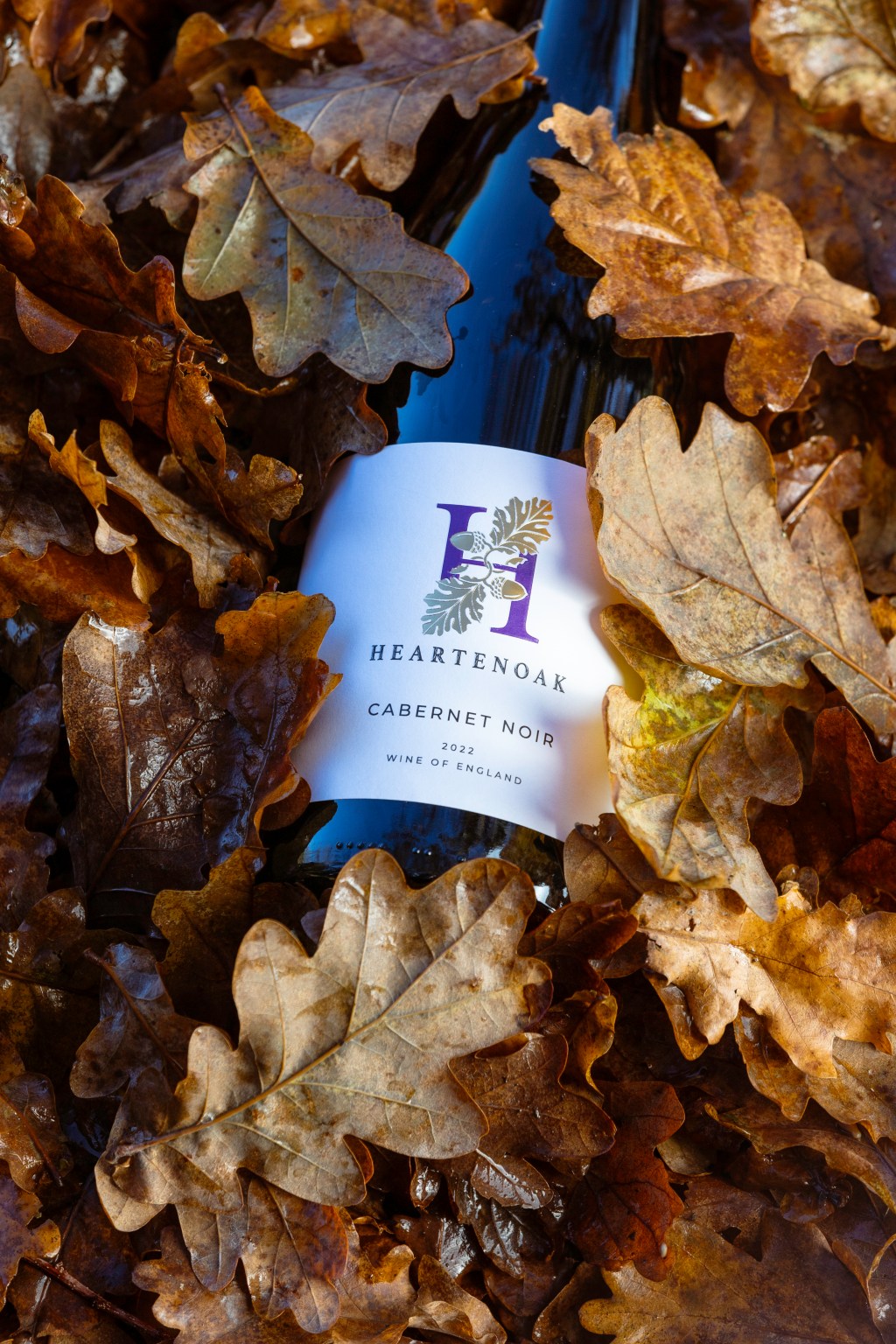As visitors arrive at Beals Green Farm the home of Heartenoak Vineyard, Hawkhurst one of the first things you notice is the plethora of ancient oak trees that cover the site. The vineyard planted in 2020 is owned and managed by husband and wife team David and Sue Ford.
In particular one large tree is a remarkably poignant reminder that from adversity can come triumph. The mighty tree lies on its side “felled by a storm long before we arrived here,” said David (possibly the storm of 1987 that felled so many trees in the area) and yet from its trunk grow new trees sturdy and secure on this foundation born of adversity.
Having purchased the farm, which now consists of 53 acres, as a place to raise their family David and Sue worked hard to renovate the farmhouse. “It was the land that sold the house,” said David. “In theory the house had heating,” added Sue with a smile as she thought back to those early days. Both David and Sue explained that although the farmhouse was not really habitable the planning process for renovations and extension had been extremely difficult. Sitting in their comfortable kitchen with its well used aga David and Sue describe how this space was used by their daughter Immie and her boyfriend Euan McDonnell to add the wax tops to the bottles of their first vintage, Cabernet Noir 2022.
Twenty years ago when the family bought the land there was one particular south east facing slope that David thought would be planted with vines one day. This vision has expanded and now there are several fields totalling 10 acres planted with 15,000 vines in 2.2m rows that make up Heartenoak Vineyard. “The patchwork nature of the High Weald means we lose some space,” explained David.
However the original field that David had pictured as the vineyard has been left untouched – having provided the inspiration the slope proved to be a little too sloping. “One of the other slopes on the farm is used by people from miles around in the snow as a toboggan run,” said David.
In 2018 David and Sue entered into conversations with a local winery. A practical way to ensure that the grapes they were growing were going to produce a wine at the end of each season. That conversation resulted in a plan to plant the three traditional sparkling wine varieties of Chardonnay, Pinot Noir and Pinot Meunier. Just when David and Sue thought the details were being finalised the winemaker suddenly decided that they did not want to proceed, due to a large harvest, and the couple were left having to rethink their entire plan. In a move that is remarkably loyal David and Sue refused to name the winemaker choosing instead to point to those in the industry who have been helpful on their journey.
Eminently adaptable and not to be deterred from their desire to see vines growing on their land they decided to delay their planting for a year and turned to the team from VineWorks for advice. “This was probably a good thing because it gave us extra time to prepare the land,” said David. Whilst undertaking the soil analysis and discussing the possibilities VineWorks recommended Divergent Drinks who produce Fitz, a charmat method wine.
With that the variety choice shifted and in 2020 there began the planting of quite recognisable varieties such as Bacchus, Seyval and Reichensteiner passing through to the unusual Pinot Blanc and moving into the innovative Caberet Noir (a PIWI variety).
David and Sue looked at what they wanted to achieve from their wines “I really wanted to be able to produce a full bodied English red in a style that is not available with English Pinot Noir,” said David. He later explained that he enjoys both Malbec and Rioja so this move towards producing a more full bodied red means he is growing grapes for a wine style that he enjoys whilst Sue pointed to Italian style Primitivo as a wine she enjoys.
The Caberet Noir is a variety that is suited to the marginal climate here in the UK and means that inputs can be significantly reduced bringing with it reduced costs and significant environmental benefits.
After the initial planting by VineWorks David and Sue found themselves faced with the task of fitting nearly 15,000 vine guards. “I put out a notice on social media to our neighbours and we were overwhelmed by their willingness to come and help,” said David. “The 2.2m row planting proved the perfect social distancing tool during lockdown,” he added smiling. It is impossible to miss the irony that had Heartenoak Vineyard planted the year they had intended (2019) then they would not have had so many people sitting at home willing to take up the request for help. In the end there were significant benefits from the delay not just for Heartenoak but for their neighbours who benefitted from the ability to be outside when so many across the country were trapped. Harvest has also been a time when the neighbours and family members have worked together to get the job done. “The harvest is spread out across the varieties, which is convenient for hand harvesting,” explained David.
When it comes to the topic of help David and Sue are eager to explain the benefits they have received from Rob Saunders of Hutchinsons who is the agronomist for Heartenoak Vineyard. “Rob is what I would describe as a thoughtful agronomist and a thoughtful person,” said Sue “He will pass on knowledge. He is local and so he knows exactly what is needed, he also visits us every fortnight,” added David.
There are benefits too for the neighbouring business Ten Oaks Equestrian Centre. The centre is able to ride round the vineyard by agreement and there is also a footpath that passes through the vineyard. The connection between Heartenoak Vineyard and the local area is obvious and quite touching.
The first harvest was collected in 2022 and three wines were produced: a charmat method Sparkling White, a single variety Bacchus and a single variety Cabernet Noir. The label for the wines really captures the feel of Heartenoak with a simple design incorporating an oak leaf. There really is no better symbol of what has been achieved at Heartenoak but it also highlights the potential for growth and regeneration which is at the centre of a visit to this beautiful vineyard.
With their first bottles delivered from Divergent Drinks, Heartenoak were preparing for their first full summer season offering tours and wine tastings in their converted 16th Century Barn but in March 2023 tragedy struck. The barn which David had been renovating by hand for four years was destroyed by fire. “The fire burned so hot it melted copper,” said Sue. In fact, the farmhouse was only saved because a fire engine that carried foam arrived just in time. Remarkably whilst the barn was totally destroyed the ancient oak tree nearby although requiring remedial work was also able to be saved.
David points to a beautiful wooden breakfast bar in the kitchen and explained that he had made this by hand using his Alaskan sawmill “with some help from the university of You Tube,” he joked. The tasting room he explained had also been made in this style by his own hand. For a brief moment the room is filled with sadness as David and Sue look out onto the now empty space that once housed the old barn in which the tasting room was situated, into which they had put so much work.
Whilst the heartache the fire has caused is evident David and Sue refused to let it discourage them and they have maintained their positivity. I marvelled as Sue explained: “We used an old Girl Guides mess tent to conduct the tastings during the summer and now we have even had tastings in the kitchen. People who have come to do tours and tastings have specifically looked for a small family vineyard to visit.” Sitting in the cosy kitchen David explained that he leads the tours himself and it is obvious that any guest would truly feel part of this vineyards experience.
The fire has meant that Heartenoak has not been promoting their tourism offering as they would have done and they no longer have the cellar space that they intended but there have still been plenty of tours taking place. Some of the orders and tastings have been from people who are thinking of planting the Caberet Noir variety but David explained that he had also given tours to diverse groups including a stag party of 15 from the Island of Jersey and the vineyard also helped a couple start their own new beginning when an engagement took place on a wooden platform looking out over the vines.
The fire took place at the beginning of the season and the life cycle of the growing vines themselves reflected the spirit of regeneration that Heartenoak have adopted.
The 2023 Caberet Noir harvest produced about 1.4kg of fruit per vine and the lack of sprays in the vineyard was also reflected in the winery processes. The wine bottle is topped with wax to reflect the environmental possibilities that this variety creates. Looking to the future David and Sue explained that they were looking at the environmental impact of bottling so are looking at alternative sustainable ideas such as KeyKeg, a large volume format that will allow them to serve wine by the glass for their tastings but saving on the production of numerous glass bottles. They are also looking into selling locally to the on-trade and Sue who was formerly a lawyer is ensuring the relevant licences are obtained. It would be great if the local pub can sell these wines to the local community.
For the 2023 harvest the best plots of Reichensteiner were producing 3kg/vine and the Bacchus 2.5kg/vine. There are some plots of Reichensteiner that are not cropping as well and David suggested this may be down to the knock on effect of Downy Mildew attack in the 2021 season. Although the vines were not cropping David has noticed that the vines that were worst affected during 2021 only achieved 1.5kg/vine in 2023.
David admitted that as a relatively new grower the 2023 season had proved a difficult balancing act. Crop thinning is not an exact science even for those with experience of many vintages and estimates and predictions proved particularly troublesome. For example, September proved to be far more beneficial in terms of weather than either July or August would have suggested. “The GDD was level with 2022 but the patterns were different,” David said.
The first harvest in 2022 produced 8.5 tonnes of total fruit but in 2023 that figure increased to 32.5 tonnes. “This was a massive crop but Divergent were able to take everything,” said David with a grateful sigh.
The vineyard is in an Area of Outstanding Natural Beauty and this has at times meant that certain rules have to be applied. For instance, on one of the boundaries is an area designated as Ancient Woodland and so extra space must be left between this and the vines. The whole farm has been part of the Sustainable Farming Incentive for the past two years. Sue has anecdotal evidence that suggest biodiversity has increased on the vineyard but “it can be a tricky balance,” she said.
“Obviously we want to increase the biodiversity but we do not want to create an environment in which there are predators for the grapes.” The vineyard put up nets every year to protect the Caberet Noir from bird attack. “The higher sugar levels seem to make these more attractive to the birds,” said David.
“Taking the nets down again takes longer than putting them up,” said Euan McDonnell who helps David and Sue perform these labour intensive tasks in the vineyard. It is clear that netting the vines is not a job that is enjoyed by either David or Euan. One of the pests that David, Sue and Euan all mention are pheasants from a local shoot that have taken to enjoying the low hanging grape bunches.
“We are getting more and more equipment but this year we ended up topping the vines with a sickle,” David said with a laugh. “I am sure we will be more organised next year,” he added. On the subject of pruning David explained: “It is great to have something to get you out in January and February, I have been out in the snow pruning, with my daughter Annabel, it was great. You need something to get you out.” Whilst I am sure there are those who are not sure about this sentiment David did mention that he has invested in electric secateurs for the coming pruning season.
Whilst the destructive flames of fire have been felt deeply at Heartenoak Vineyard both the oak tree that survived that fire and the fallen tree that has spawned new life give heart and inspiration not only To Heartenoak Vineyard but to all of us. David and Sue have adapted and not abandoned their plans. Speaking about the future it is clear there are plans to rebuild but beyond that come plans to have a pink fizz that will incorporate the Caberet Noir. David and Sue also mention that more vines in the future would also be an option. Alongside this David mentions his desire to start a wine library for the estate which shows an admirable determination not to let the problems of the present imperil future progress.
- David and Sue Ford

